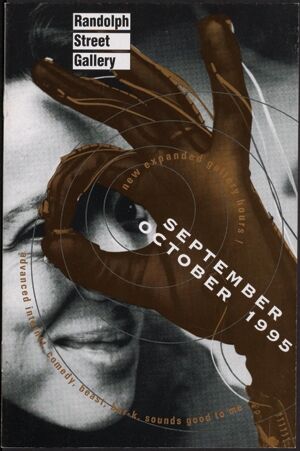
A Moment in SAIC History

by Emily Margosian (MA 2015)
A place of experimentation and community, the Randolph Street Gallery (RSG) was an influential artist-run space in Chicago best known for its incubation of emerging, noncommercial art forms. During its nearly 20-year lifespan, from 1979 to 1998, the gallery developed a deep commitment to artists within Chicago and beyond through its exhibitions, performances, and outreach.
For most of the 1970s, budding alternative spaces such as the Randolph Street Gallery offered artists legitimate venues to develop nascent forms of artmaking, such as video and performance art. “Randolph Street Gallery was really a hub of activity that supported a full range of practices. You could go to this place and immediately hook into a diverse center of ideas,” says Lin Hixson, a former RSG participant and current SAIC faculty member. Many of these new alternative spaces relied on the artists themselves to curate shows, with participating artists receiving payment for exhibiting. Few places, however, took performance art as seriously as RSG.
Founded by two artists in 1979, Randolph Street Gallery moved from its Randolph Street storefront to its final location on North Milwaukee Avenue in 1982. The new space included an exhibition gallery, a black-box performance space for time-based art, and a project space. More than a thousand artists exhibited their work there, many of them SAIC alumni. Xu Bing, Andres Serrano, Robert Blanchon, Leon Golub, Eve Andre Laramee, and James Luna were all Randolph Street Gallery participants.
In addition to national and international artists, RSG involved students, particularly those from SAIC. “Students showed work and performed there with both finished pieces and works in progress,” says Hixson, “SAIC had a huge connection.”
Artist and SAIC alum Daviel Shy (MFA 2013) has worked with the Randolph Street Gallery Archives, which are housed in SAIC’s John M. Flaxman Library. After researching some of the archives’ videos, posters, multiples, and event calendars, she says, “It is just incredible to see something so lively and rich. I feel like there was a long gap in terms of an experimental performance space in Chicago after Randolph Street closed.”
Over time the gallery’s focus expanded to address the leading social issues of the day, engaging in larger conversations on LGBTQ, racial, and class concerns. Seminars and educational programs spurred discussions on homelessness, discrimination, and the looming AIDS crisis.
Randolph Street Gallery also oversaw a grant program for regional artists that distributed nearly $200,000 between 1989 and 1996, and produced 44 issues of P-Form, a quarterly devoted to performance and interdisciplinary art from 1986 to 1997. However despite the commendable efforts of volunteers and staff, operating expenses increased dramatically, culminating in RSG shutting its doors permanently on February 13, 1998, during a time when many alternative spaces around the country were also struggling.
Randolph Street Gallery embodied the crucial role that alternative spaces have historically served: providing artists with research-and-development facilities while connecting with audiences as conduits of American cultural discourse. The relative youngness of the space means its participants are alive and collaborating with contemporary artists. Many were excited to have their work revisited in Hixson’s 9 Beginnings: Chicago project, in which the beginnings of nine separate pieces selected from the Randolph Street Gallery Archives were re-performed as a singular work.
Despite its disbandment, the Randolph Street Gallery is deeply rooted in Chicago’s DIY scene. “I think Randolph Street’s presence is felt more today than maybe in the past 10 years,” says Shy. “There wouldn’t be an art scene in Chicago without DIY spaces. There are ways in which established artists are still very much invested in alternative spaces and economies in this city. It’s very rich. The spirit of Randolph Street Gallery is still very much alive.”
